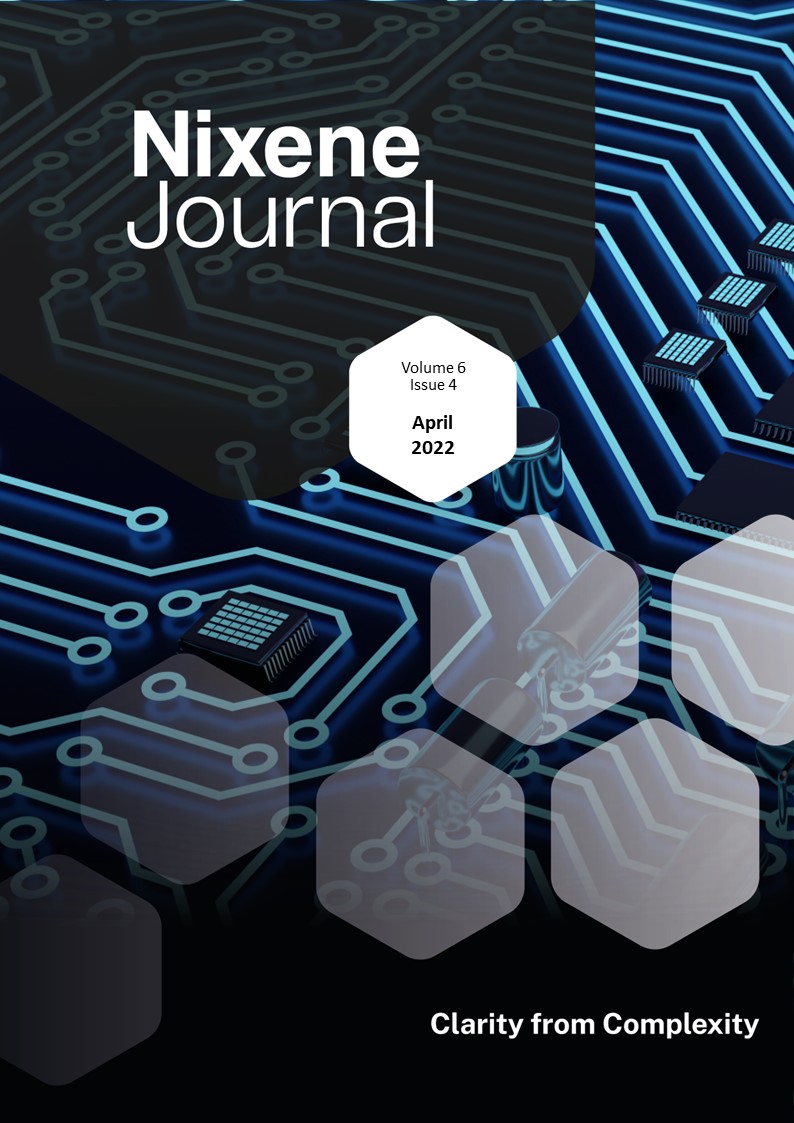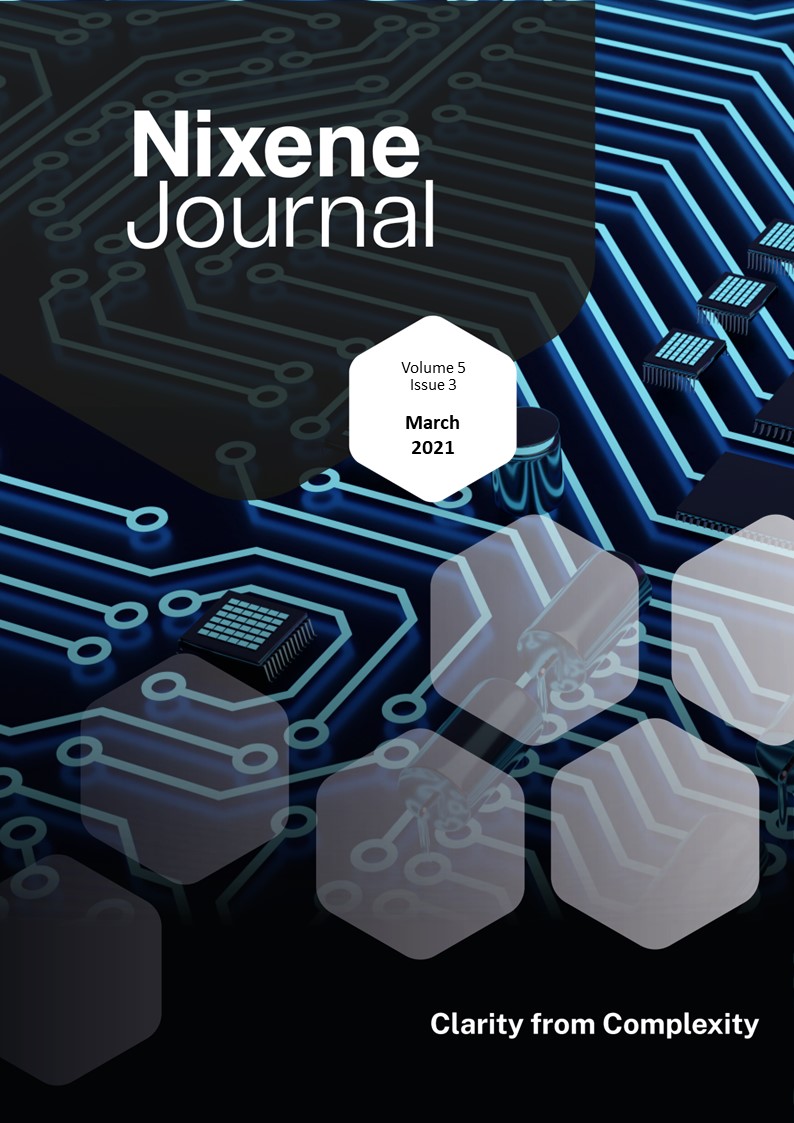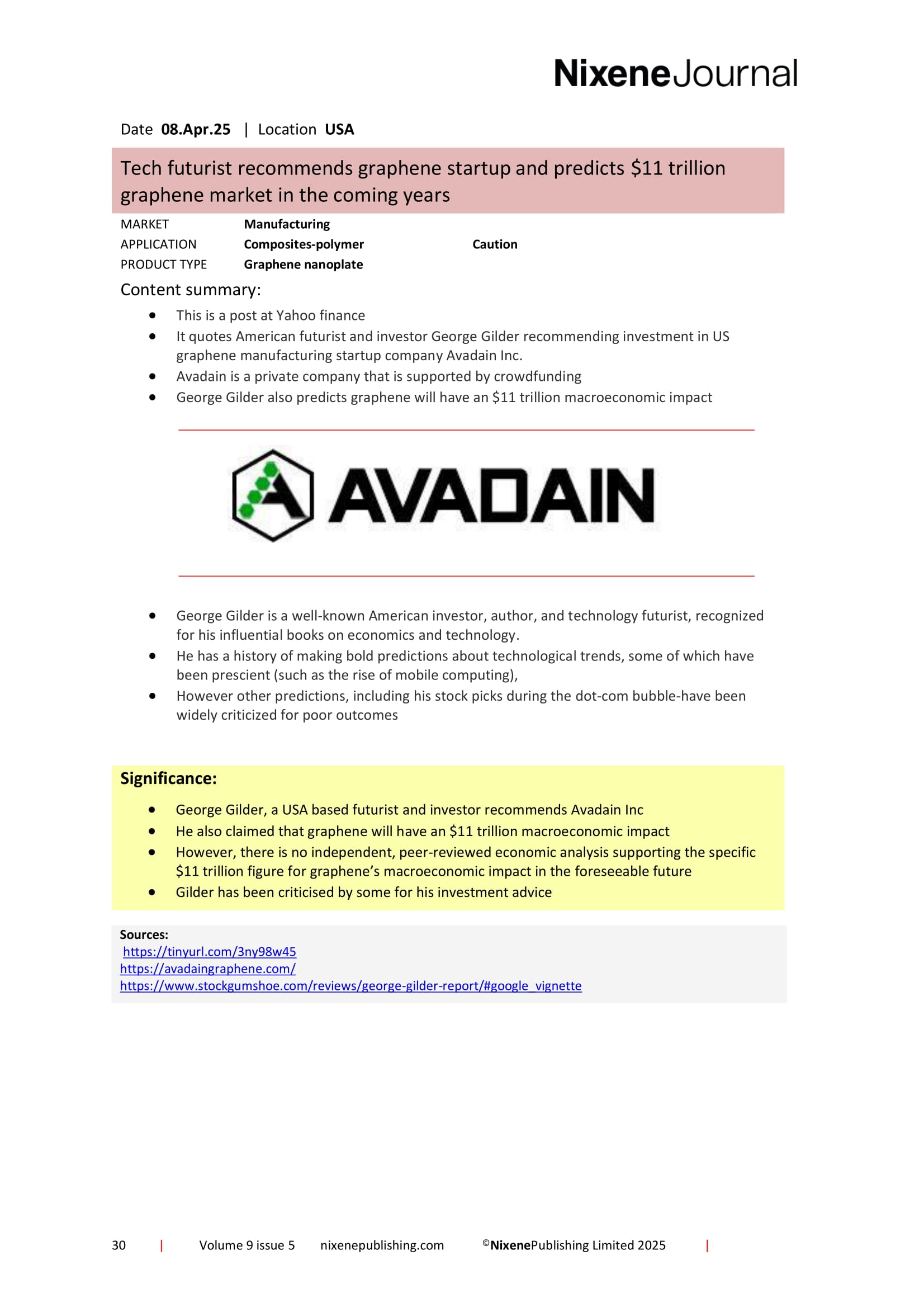Journals
This product is relevant to the following:
Material:
Other:
, ,Locations:
Markets:
Applications:
Product Types:
Technologies:
Related products
-

Vol 5 Issue 2
Regular readers will be aware of my view that the field of graphene is moving faster than anyone realises. More evidence supporting this emerged this month. A team at Penn State university in the USA has been working on experiments with passing sound waves through sheets of graphene with precise holes drilled in hexagonal patterns. They made the acoustic analogue of twisted bilayer graphene and found the acoustic equivalent of the magic angle. So, as well as twistronics for electrons we now have phononics for sound waves in twisted bilayer graphene, and probably other 2D materials. A new field of scientific study made possible by graphene the progress really is astonishing. The US Government is starting to wake up to the power of graphene. James Tour’s flash graphene is attracting the attention. The team now can take the waste char from plastic recycling and turn it in to graphene that improves the strength of cement by 30%. Rice University says the Air Force Office of Scientific Research and the Department of Energy supported the research. Trade magazines in the construction sector are also picking up on this. Another development by James Tour; Laser induced graphene is being used to make biosensors that detect and diagnose SARS-CoV-2 in blood and saliva samples. The test links to a smartphone and produces results in ten minutes. More work is being done with graphene supercapacitors. It looks like increasing the surface area of graphene nanoplates by increasing the separation between the nanoplates increases the energy density. Cross linking the nanoplates with a big molecule that is also electrically conductive improves the supercapacitor performance still further. Computer graphics card manufacturer, Gigabyte, has launched a new high end gaming card. Graphene is being used to improve the cooling performance, interestingly not using the thermal properties, but using graphene as a lubricant. Investors seem to be taking a more active interest in graphene companies. Ionic, the Australian supercapacitor manufacturer has received $2million to develop its manufacturing operation. In the UK Versarien has raised another £3.5million and Applied Graphene Materials has raised £6million in cash by selling more shares. This gives both companies some financial breathing room but also raises the pressure to deliver revenue growth. And there is lots more of interest in this packed issue. Adrian Nixon, 1st February 2021£45.00 View product -

Vol 6 Issue 4
We begin this month with a review of a new book by James Baker and James Tallentire – “Graphene: The Route to Commercialisation.” This book will be released later this month and well worth a read. It is part history of the graphene story and part how-to-guide to create a sustainable innovation ecosystem for new advanced materials. Graphene composites are making the news. The graphene-asphalt road trials in the UK have produced successful results. Oxfordshire County Council reports that graphene-enhanced asphalt improves the life of the road surface by 70%, and graphene enhances the stiffness of the surface, making it less prone to rutting. Another trial is underway on a 700m stretch of road with heavier traffic to see if similar benefits are reported. Korea is experimenting with graphene-metal composites to build new power lines for its electricity grid. The national power company announced a research project to enhance the power transmission capacity of the country’s energy distribution network. On a smaller scale, researchers in the USA are using graphene oxide scaffolds to create new bone using stem cells. Graphene oxide has been making more appearances on social media. Reuters felt compelled to investigate claims that graphene oxide was being put into ibuprofen tablets. Their conclusion was that these are false claims. Elsewhere, rather serious accusations are starting to emerge about one of Canada’s biggest graphene companies. Zentek (previously Zen Graphene Solutions) has been accused of unethical business practises. Prof. Rodney Ruoff’s group in Korea have been working with teams in Saudi Arabia and China to make large area single-crystal graphene. They used the chemical vapour deposition (CVD) process but allowed graphene to diffuse into the copper metal close to its melting point. This grew the graphene at the interface between the metal and a sapphire substrate. They added another clever step by diffusing nitrogen into the copper then rapidly heating the sample. This caused the nitrogen to expand, blowing off the copper, leaving the graphene exposed and undamaged. We can expect the team to speed up and scale up the process over the coming years. This team is one to watch. There are many more things to watch out for in this issue, dear reader. I will delay you no longer and let you dive into this month’s carefully curated content… Adrian Nixon, 1st April 2022£45.00 View product -

Vol 6 Issue 2
A graphene toaster was demonstrated for the first time at the consumer electronics show in Las Vegas by Korean company Graphene Square. This may not sound like a world changing invention, but it is something worth paying attention to because this is a rare application for chemical vapour deposition (CVD) graphene in a consumer electronics device. Until now, CVD graphene has been used in very small pieces in sensors. This toaster has a piece of CVD graphene on the top and bottom glass panels making a transparent infrared grill. The graphene is made at a scale of 200mm x 150mm and this tells us a that the company has a viable CVD roll to roll process. The process can make graphene at this scale and also provides the capability to separate the graphene from the forming substrate to other surfaces, in this case glass. The next step is to do this commercially. Graphene Square admits this is still at least a year away. This is still impressive progress and tells us that the industrial manufacture of CVD graphene is developing quickly. CVD graphene is also in the news this month. British company Paragraf announced through Queen Mary University, London, that they can create graphene at wafer scale, and this could be a replacement for indium tin oxide (ITO). This was picked up by technology blogs around the world, and graphene manufacturer Versarien felt obliged to disclose it is working on a similar project with a graphene manufacturer in Korea. These announcements about CVD graphene touchscreens sound impressive. However, as far as we can tell from the current state of the art, the economic and technical cases are not sufficiently proven to convince us we will see this technology in the immediate future. The term ‘bottom-up graphene’ used to refer to CVD graphene assembled atom by atom. Graphene powder manufacturing has been evolving rapidly over the last few years and can now be made by atomic assembly methods too. We have summarised the various methods in our special feature. We also look at the implications for competitive activity, as these new manufacturing methods meet the new market dynamics driving the sustainability agenda. While we cannot state which individual companies will achieve success, we can make some predictions about the characteristics successful graphene powder manufacturers will need to have. We hope you agree this makes for fascinating reading along with the rest of the compelling content this issue. Adrian Nixon, 1st February 2022£45.00 View product -

Vol 5 Issue 3
Graphene and 2D materials are still creating scientific progress and the pace is if anything speeding up. You may recall from 2018 that MIT discovered twisted bilayer graphene displayed superconductivity. Andre Geim said this was a genuine surprise when we interviewed him at the Graphene industry showcase event (Vol 4 Iss1 p.8). Well, the MIT team have been exploring this field of twistronics and have now found that using trilayer twisted graphene creates more robust superconductivity at slightly higher temperatures. This points the researchers towards more layers of graphene. Maybe people will start to realise multilayer sheet graphene is much more than graphite. In another development, liquid mercury has been turned into a solid by graphene and the resulting composite has promise for making a new generation of catalysts that could replace more expensive noble metals such as platinum and gold. This finding might also create the possibility to remove liquid mercury contamination from oil and gas processing. Sparc technologies in Australia has some profile this month. They have developed a functionalised graphene with the University of Adelaide. This is showing promise for land remediation and also early work is showing it has some value adsorbing precious metals from mining waste. Sustainability applications like these attract our attention, especially if followed by commercial success. Swedish company 2D fab is working on a project with Swedish research institutes to commercialise a new process for making hydrogen peroxide (H2O2) using graphene paper electrodes. H2O2 is an important industrial product used for bleaching and is an important ingredient in many consumer products. The current process for making H2O2 is energy intensive and creates waste. This new process promises to be lower energy without waste and is more environmentally sustainable. The project should complete by April 2023. Keeping the sustainability theme this month, we also see that the GEIC has started to engage with graphene enhanced concrete, This is really good news. Regular readers will know that we believe graphene in concrete will eventually become the biggest application because it has the potential to reduce global carbon dioxide emissions by 2% with very little impact on our lifestyles. A message that perhaps might reach the ears of those attending the UN Climate Chance conference later this year. As usual there is so much more to explore in this issue, including two special features by Debbie Nelson that are well worth reading. Adrian Nixon, 1st March 2021£45.00 View product



